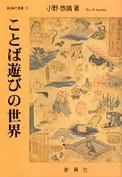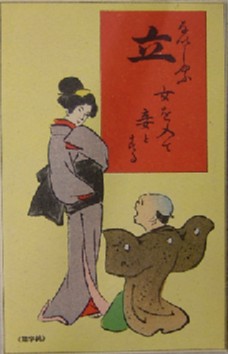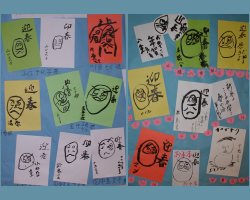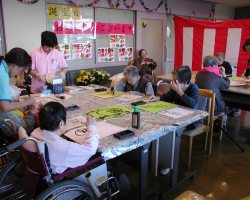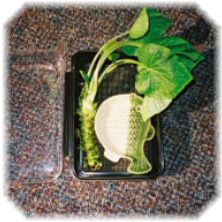:::::::::::::::::::::::::::::::::::::::::::::::::::::::::::::::::::::::::::::::::::::::::::::::::::::
Yukidaruma Bentoo Box
Lunchbox with a Snowman Daruma
The town of Niitsu in Niigata Prefecture prepares various lunchboxes served in colorful plastic Daruma boxes.

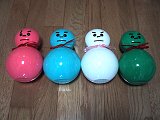
隠れた駅弁大駅である新津に1987(昭和62)年に登場した駅弁。プラスティック製の白い雪だるま型容器が本当にかわいらしく、駅弁大会で何十個と陳列されると壮観。中身は鶏めし弁当風で、頭の部分が鶏そぼろ御飯、胴体の部分は御飯の上に鶏もも肉・数の子・椎茸・山菜・カニ蒲鉾・錦糸卵などが載る。御飯はもちろん新潟米コシヒカリ。容器は白の他に黄・青・緑・赤があり、こちらは予約しないと入手できなかったが、遠隔地での駅弁大会で実演販売があれば見られることがある。
Even a BLACK snowman Daruma is available.
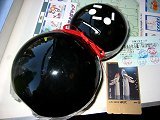
Some other snacks with nuts and crackers in a Daruma box
雪国あられと柿の種
「雪だるま弁当」の容器を使用、頭の部分に柿の種を、胴体の部分に雪国あられを詰めた袋を収めるもの。容器の色が普通の白でも団体予約用の赤・黄・緑・青でもない橙色である点が興味深い。
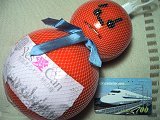

Copyright (C) 2001-2006 まっこうくじら All Rights Reserved.
http://eki-ben.web.infoseek.co.jp/15niigata_nitsuy.htm
:::::::::::::::::::::::::::::::::::::::::::::::::::::::::::::::::::::::::::::::::::::::::::::::::::::

He No He No へのへの
Painting the Daruma Face with letters
A way children learn to write letters.
HE is for the eyebrows, NO for the eyes.
MO も is for the nose and the final
HE is for the mouth.

One more photo
HE NO HE NO, some fun with Farting
へのへのもへじ Wikipedia

Click for more HE NO items !
:::::::::::::::::::::::::::::::::::::::::::::::::::::::::::::::::::::::::::::::::::::::::::::::::::::
Shingen Bento Boxes
Wood with red laquer

Wood with black laquer

Detail of the above

Photos from my friend Ishino.
:::::::::::::::::::::::::::::::::::::::::::::::::::::::::::::::::::::::::::::::::::::::::::::::::::::
TAKABEN, the famous lunch box with
Takasaki Daruma
has been reproduced lately.
高崎の「だるま弁当」


Here you can see the contents


Click on the photo to see MORE !
Daruma Relief at Takasaki Train Station
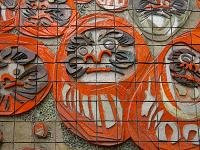
::::::::::::::::::::::::::::::::::::::::::::::::::::::::::::::::::::
三面ダルマ焼
sanmen Daruma yaki
Daruma with three faces, from Takasaki
a cookie
a smiling face to lure good luck
a face with two open eyes to open good fortune
a face to keep harmony with the sourroundings
The eyebrows in the form of a crane
the beard a symbol for long life.
一面・笑顔で福を招き
二面・両目開眼で運を開き
三面・周囲との調和を願う
眉は鶴、髪は長寿を表す。

© Itibou-Kaku
群馬県高崎市石原町2340-1
:::::::::::::::::::::::::::::::::::::::::::::::::::::::::::::::::::::::::::::::::::::::::::::::::::::
Bentobox from Nagoya Shinkansen Station
東海道新幹線 : 名古屋駅

And a Daruma Miso-Don
だるまのみそ丼

© PHOTOs : kun.ciao.jp/kunkun
:::::::::::::::::::::::::::::::::::::::::::::::::::::::::::::::::::::::::::::::::::::::::::::::::::::
「ダルマ」弁当, 達磨弁当

© PHOTO : charaben.at.webry.info
:::::::::::::::::::::::::::::::::::::::::::::::::::::::::::::::::::::::::::::::::::::::::::::::::::::



CLICK for many more photos !
:::::::::::::::::::::::::::::::::::::::::::::::::::::::::::::::::::::::::::::::::::::::::::::::::::::

ぷちサンプル 駅弁紀行 だるま
. . . CLICK here for Photos !
:::::::::::::::::::::::::::::::::::::::::::::::::::::::::::::::::::::::::::::::::::::::::::::::::::::
Magewappa, magewappa Bento Boxes
まげわっぱ / 曲げわっぱ
magemono 曲物 cirulare box
 Magewappa was first made by woodcutters in the Odate area, using straight grain Akita Cedar. The Lord of Odate Castle, Nishiie Satake, encouraged this use of the soldiers and has been passed on from generation to generation from the end of the Edo Era to the present. With the emergence of plastics, it became economically necessary for some craftsmen to change their business. Since then more people are becoming aware of real quality and craftsmanship.
Magewappa was first made by woodcutters in the Odate area, using straight grain Akita Cedar. The Lord of Odate Castle, Nishiie Satake, encouraged this use of the soldiers and has been passed on from generation to generation from the end of the Edo Era to the present. With the emergence of plastics, it became economically necessary for some craftsmen to change their business. Since then more people are becoming aware of real quality and craftsmanship. 
Odate Magewappa 大館曲げわっぱ fits this description perfectly.
For more than four hundred years our ancestors have exploited mountains, planted Japanese cedars, and repeated the process of weeding, pruning, and thinning out the forests every year to protect the beauty and health of the environment for the next generation
© More in the WIKIPEDIA !
:::::::::::::::::::::::::::::::::::::::::::::::::::::::::::::::::::::::::::::::::::::::::::::::::::::
. chigibako 千木筥 / 千木箱 auspicious box .
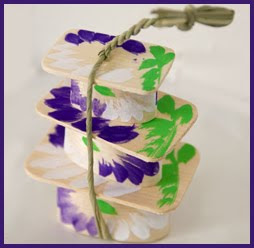
from the shrine Shiba Daijinguu 芝大神宮
Tokyo
akinai mamori 商い守り amulet to protect business
- source : www.shibadaijingu.com
. shoobai hanjoo 商売繁盛 good business amulets .
:::::::::::::::::::::::::::::::::::::::::::::::::::::::::::::::::::::::::::::::::::::::::::::::::::::
Bentobako Ekiben Bentobox
Bentoobako - Lunchbox with Daruma
. - Backup text of this entry -
Yukidaruma - Daruma as a Snowman 雪だるま―冬の散歩
- Backup text of this entry -
World Kigo Database: Lunchbox (bentoo) and Haiku
World Kigo Database: Snowman (yukidaruma) and Haiku
:::::::::::::::::::::::::::::::::::::::::::::::::::::::::::::::::::::::::::::::::::::::::::::::::::::
WASHOKU ... Tableware and Tools
WASHOKU : Ekiben 駅弁 station lunchbox
:::::::::::::::::::::::::::::::::::::::::::::::::
[ . BACK to WORLDKIGO . TOP . ]
[ . BACK to DARUMA MUSEUM TOP . ]
:::::::::::::::::::::::::::::::::::::::::::::::::::::::::::::::::::::::::::::::::::::::::::::::::::::

